Responses of Branch Number and Yield Component of Soybean Cultivars Tested in Different Planting Densities
Abstract
1. Introduction
2. Materials and Methods
2.1. Experimental Site
2.2. Experimental Design
2.3. Plant Sampling and Analysis
2.4. Statistical Analysis
3. Results
3.1. Response of Yield and Yield Components to Planting Density
3.2. Response of Branching to Planting Density
3.3. Relationship between the Number of Seeds and Pods, and Branches
3.4. Branch Yield Contribution Rate
4. Discussion
5. Conclusions
Author Contributions
Funding
Institutional Review Board Statement
Informed Consent Statement
Data Availability Statement
Acknowledgments
Conflicts of Interest
References
- Song, W.; Yang, R.; Wu, T.; Wu, C.; Sun, S.; Zhang, S.; Jun, B.; Tian, S.; Liu, X.; Han, T. Analyzing the effects of climate factors on soybean protein, oil contents and compositions by extensive and high-density. J. Agric. Food Chem. 2016, 64, 4121–4130. [Google Scholar] [CrossRef]
- Carciochi, W.; Schwalbert, R.; Andrade, H.; Corassa, G.; Carter, P.; Gaspar, P.; Schmidt, J.; Ciampitti, I. Soybean seed yield response to plant density by yield environment in North America. Agron. J. 2019, 111, 1923–1932. [Google Scholar] [CrossRef]
- Oslaj, M.; Mursec, B.; Vindis, P. Biogas production from maize hybrids. Biomass Bioenergy 2010, 34, 1538–1545. [Google Scholar] [CrossRef]
- Mauser, W.; Klepper, G.; Zabel, F.; Delzeit, R.; Hank, T.; Putzenlechner, B.; Calzadilla, A. Global biomass production potentials exceed expected future demand without the need for cropland expansion. Nat. Commun. 2015, 6, 8946. [Google Scholar] [CrossRef] [PubMed]
- Yin, Y.; Xu, C.; Song, W.; Hu, S.; Wu, C. Increasing planting density is an important approach to achieve the potential of soybean yield. Soils Crops 2019, 8, 361–367. [Google Scholar] [CrossRef]
- Purcell, L.C.; Ball, R.A.; Reaper, J.D.; Vories, E.D. Radiation use efficiency and biomass production in soybean at different plant population densities. Crop Sci. 2002, 42, 172–177. [Google Scholar] [CrossRef]
- Gan, Y.; Stulen, I.; Van Keulen, H.; Kuiper, P.J.C. Physiological response of soybean genotypes to plant density. Field Crops Res. 2002, 74, 231–241. [Google Scholar] [CrossRef]
- Zhang, W.; Zhang, H.; Wang, H.; Xie, F.; Chen, Z. Effects of spacings and planting densities on agronomic traits and yield in high-oil soybeans. Soybean Sci. 2006, 25, 283–287. [Google Scholar] [CrossRef]
- Xu, C.; Huang, S.; Tian, B.; Ren, J.; Meng, Q.; Wang, P. Manipulating planting density and nitrogen fertilizer application to improve yield and reduce environmental impact in Chinese maize production. Front. Plant Sci. 2017, 8, 1234. [Google Scholar] [CrossRef]
- Hightower, M. Arkansas Producer Smashes State Soybean Yield Record. Delta Farm Press Exclusive Insight, 2014. Available online: http//connection.ebscohost.com/clarticles/98312029 (accessed on 7 January 2021).
- Wang, X.G.; Zhao, N.L.; Wei, J.J.; Dong, Z. Case analysis of super-high-yielding soybean cultivar, Zhonghuang 35. Soybean Sci. 2011, 30, 1051–1053. [Google Scholar] [CrossRef]
- Walker, E.R.; Mengistu, A.; Bellaloui, N.; Koger, C.H.; Roberts, R.K.; Larson, J.A. Plant population and row-spacing effects on maturity group III soybean. Agron. J. 2010, 102, 821–826. [Google Scholar] [CrossRef]
- Suhre, J.; Weidenbenner, N.; Rowntree, S.; Wilson, E.; Naeve, S.; Conley, S.; Casteel, S.; Diers, B.; Esker, P.; Specht, J. Soybean yield partitioning changes revealed by genetic gain and seeding rate interactions. Agron. J. 2014, 106, 1631–1642. [Google Scholar] [CrossRef]
- Zhang, R.; Fu, L.; Tong, B.; Wu, Q.; Liu, C.; Zhu, H.; Sun, G. Effect of plant density and row spacing on agronomic characteristics and yield for different soybeans. Soybean Sci. 2015, 34, 52–55. [Google Scholar] [CrossRef]
- Zhang, X.; Du, J.; Zheng, D. Effect of density on canopy structure and photosynthetic characteristics in soybean population. Agri. Res. Arid Areas 2011, 29, 75–80. [Google Scholar]
- Gaspar, A.P.; Conley, S.P. Responses of canopy reflectance, light interception, and soybean seed yield to replanting suboptimal stands. Crop Sci. 2015, 55, 377–385. [Google Scholar] [CrossRef]
- Mathan, J.; Bhattacharya, J.; Ranjan, A. Enhancing crop yield by optimizing plant developmental features. Development 2016, 143, 3283–3294. [Google Scholar] [CrossRef]
- Sun, Z.X.; Su, C.; Yun, J.; Jiang, Q.; Wang, L.; Wang, Y.; Cao, D.; Zhao, F.; Zhao, Q.; Zhang, M.; et al. Genetic improvement of the shoot architecture and yield in soya bean plants via the manipulation of GmmiR156b. Plant Biotechnol. J. 2019, 17, 50–62. [Google Scholar] [CrossRef]
- Board, J. Yield components related to seed yield in determinate soybean. Crop Sci. 1987, 27, 1296–1297. [Google Scholar] [CrossRef]
- Carpenter, A.; Board, J. Growth dynamic factors controlling soybean yield stability across plant populations. Crop Sci. 1997, 37, 885–891. [Google Scholar] [CrossRef]
- Kahlon, C.; Board, J.; Kang, M. An analysis of yield component changes for new vs. old soybean cultivars. Agron. J. 2011, 103, 13–22. [Google Scholar] [CrossRef]
- Egli, D. The relationship between the number of nodes and pods in soybean communities. Crop Sci. 2013, 53, 1668–1676. [Google Scholar] [CrossRef]
- Orlowski, J.; Gregg, G.; Lee, C. Early-season lactofen application has limited effect on soybean branch and mainstem yield components. Crop Sci. 2016, 56, 432–438. [Google Scholar] [CrossRef]
- Frederick, J.; Camp, C.; Bauer, P. Drought-stress effects on branch and mainstem seed yield and yield components of determinate soybean. Crop Sci. 2001, 41, 759–763. [Google Scholar] [CrossRef]
- Norsworthy, J.; Shipe, E. Effect of row spacing and soybean genotype on mainstem and branch yield. Agron. J. 2005, 97, 919–923. [Google Scholar] [CrossRef]
- Chen, L.; Yang, H.; Fang, Y.; Guo, W.; Chen, H.; Zhang, X.; Dai, W.; Chen, S.; Hao, Q.; Yuan, S.; et al. Overexpression of GmMYB14 improves high-density yield and drought tolerance of soybean through regulating plant architecture mediated by the brassinosteroid pathway. Plant Biotechnol. J. 2020, 1–15. [Google Scholar] [CrossRef]
- Bao, A.; Chen, H.; Chen, L.; Chen, S.; Hao, Q.; Guo, W.; Qiu, D.; Shan, Z.; Yang, Z.; Yuan, S.; et al. CRISPR/Cas9-mediated targeted mutagenesis of GmSPL9 genes alters plant architecture in soybean. BMC Plant Biol. 2019, 19, 131. [Google Scholar] [CrossRef]
- Wolters, H.; Jürgens, G. Survival of the flexible, hormonal growth control and adaptation in plant development. Nat. Rev. Genet. 2009, 10, 305–317. [Google Scholar] [CrossRef]
- Wang, H.G.; Zhang, Z.L.; Li, H.Y.; Zhao, X.Y.; Liu, X.M.; Ortiz, M.; Lin, C.T.; Liu, B. CONSTANS-LIKE7 regulates branching and shade avoidance response in Arabidopsis. J. Exp. Bot. 2013, 64, 1017–1024. [Google Scholar] [CrossRef]
- Yang, F.; Fan, Y.; Wu, X.; Cheng, Y.; Liu, Q.; Feng, L.; Chen, J.; Wang, Z.; Wang, X.; Yong, T.; et al. Auxin-to-Gibberellin Ratio as a Signal for Light Intensity and Quality in Regulating Soybean Growth and Matter Partitioning. Front. Plant Sci. 2018, 9, 56. [Google Scholar] [CrossRef]
- Coulter, J.; Sheaffer, C.C.; Haar, M.J.; Wyse, D.L.; Orf, J.H. Soybean cultivar response to planting date and seeding rate under organic management. Agron. J. 2011, 103, 1223–1229. [Google Scholar] [CrossRef]
- Place, G.T.; Reberg-Horton, S.C.; Dunphy, J.E.; Smith, A.N. Seeding rate effects on weed control and yield for organic soybean production. Weed Technol. 2009, 23, 497–502. [Google Scholar] [CrossRef]
- Lee, C.D.; Egli, D.B.; TeKrony, D.M. Soybean response to plant population at early and late planting dates in the Mid-South. Agron. J. 2008, 100, 971–976. [Google Scholar] [CrossRef]
- De Luca, M.J.; Nogueira, M.A.; Hungria, M. Feasibility of lowering soybean planting density without compromising nitrogen fixation and yield. Agron. J. 2014, 106, 2118–2124. [Google Scholar] [CrossRef]
- Wang, Q.; Xue, J.; Zhang, G.; Chen, J.; Xie, R.; Ming, B.; Hou, P.; Wang, K.; Li, S. Nitrogen split application can improve the stalk lodging resistance of maize planted at high density. Agriculture 2020, 10, 364. [Google Scholar] [CrossRef]
- Ittersum, M.K.; Cassman, K. Yield gap analysis—Rationale, methods and applications—Introduction to the Special Issue. Field Crop. Res. 2013, 143, 1–3. [Google Scholar] [CrossRef]
- Egli, D.B. Plant density and soybean yield. Crop Sci. 1988, 28, 977–981. [Google Scholar] [CrossRef]
- Holshouser, D.L.; Whittaker, J.P. Plant population and row spacing effects on early soybean production systems in the Mid-Atlantic USA. Agron. J. 2002, 94, 603–611. [Google Scholar] [CrossRef]
- Board, J.; Modali, H. Dry matter accumulation predictors for optimal yield in soybean. Crop Sci. 2005, 45, 1790–1799. [Google Scholar] [CrossRef]
- Sayama, T.; Hwang, T.Y.; Yamazaki, H.; Yamaguchi, N.; Komatsu, K.; Takahashi, M.; Suzuki, C.; Miyoshi, T.; Tanaka, Y.; Xia, Z. Mapping and comparison of quantitative trait loci for soybean branching phenotype in two locations. Breed. Sci. 2010, 60, 380–389. [Google Scholar] [CrossRef]
- Wang, C.; Wu, T.; Sun, S.; Xu, R.; Ren, J.; Wu, C.; Jiang, B.; Hou, W.; Han, T. Seventy-five years of improvement of yield and agronomic traits of soybean cultivars released in the Yellow-Huai-Hai River Valley. Crop Sci. 2016, 56, 2354–2364. [Google Scholar] [CrossRef]
- Cox, W.; Cherney, J. Growth and yield responses of soybean to row spacing and seeding rates. Agron. J. 2011, 103, 123–128. [Google Scholar] [CrossRef]
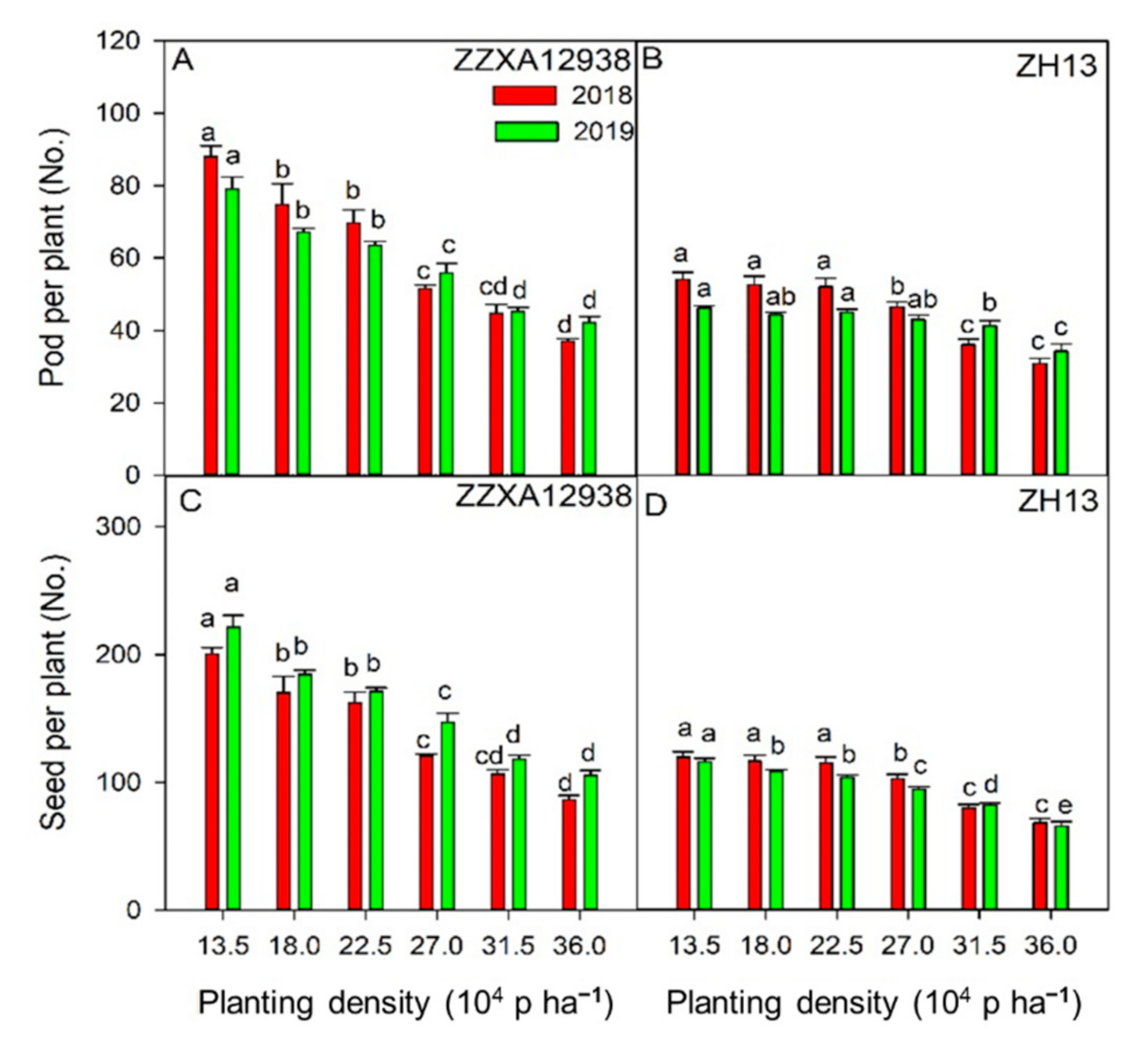
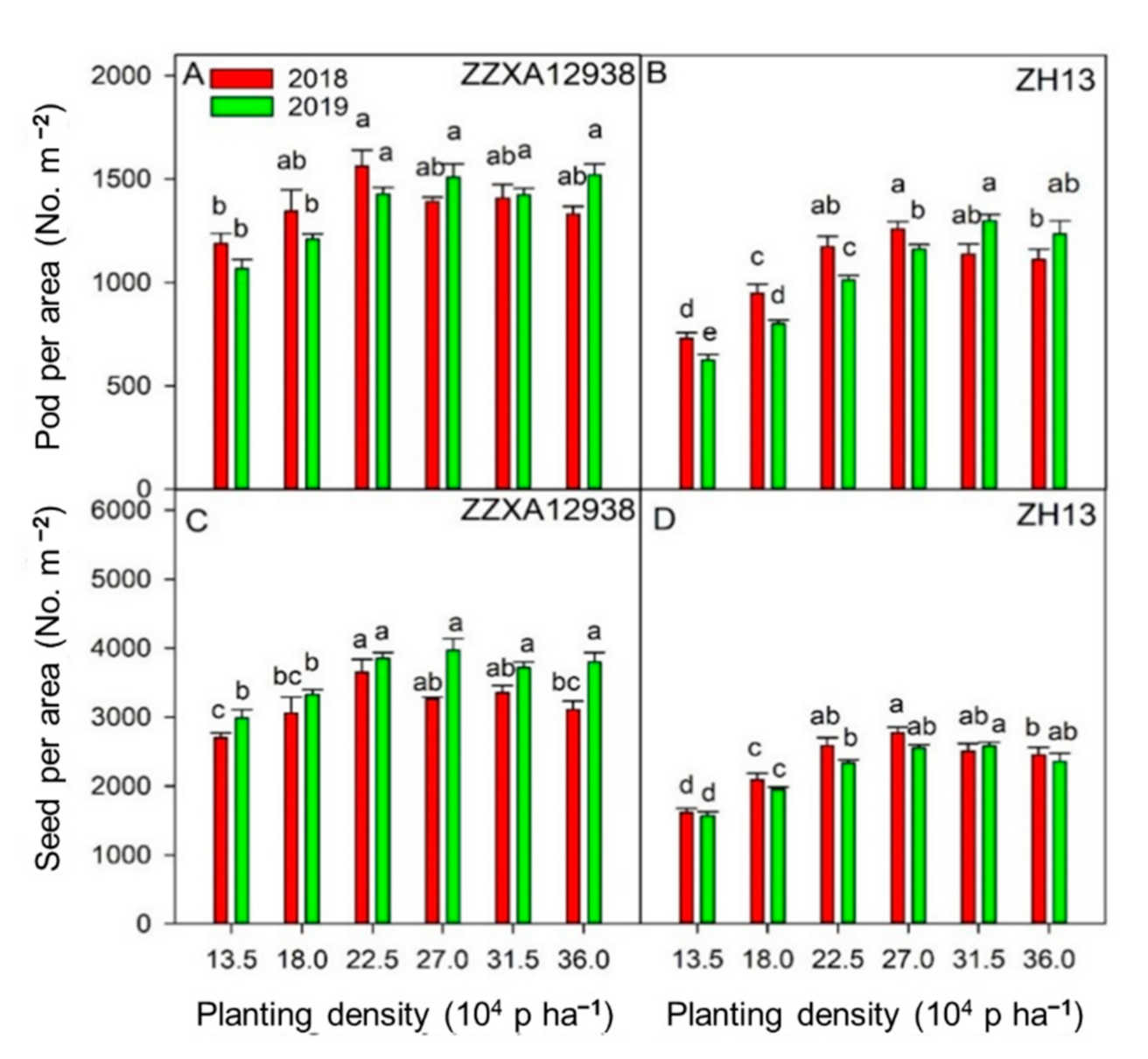
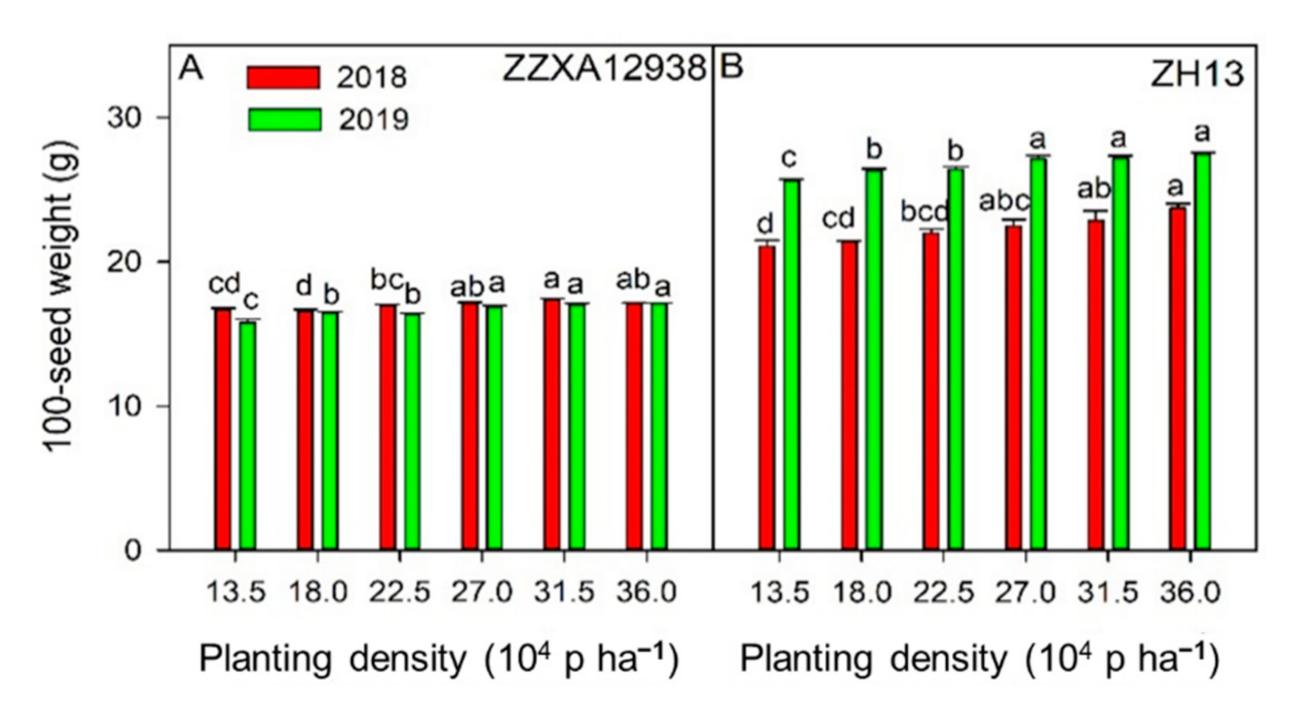
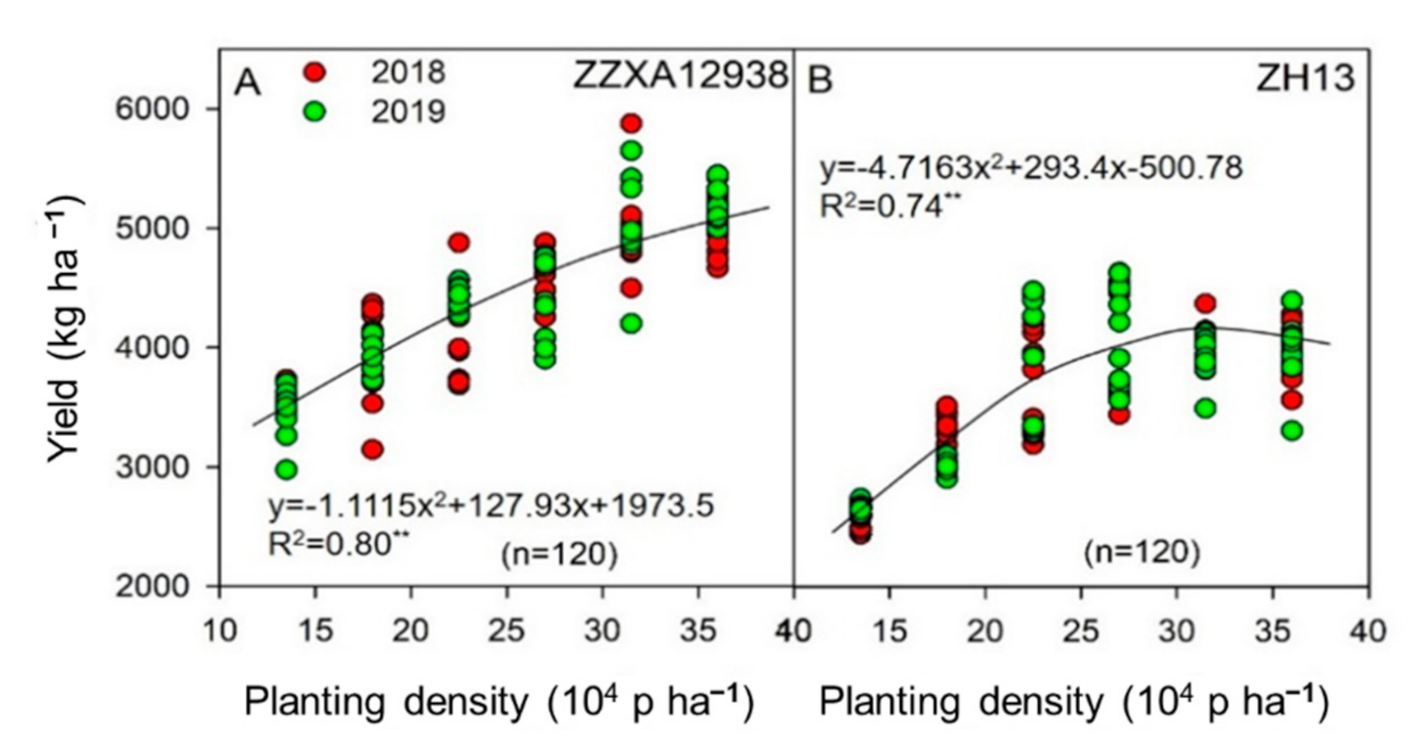
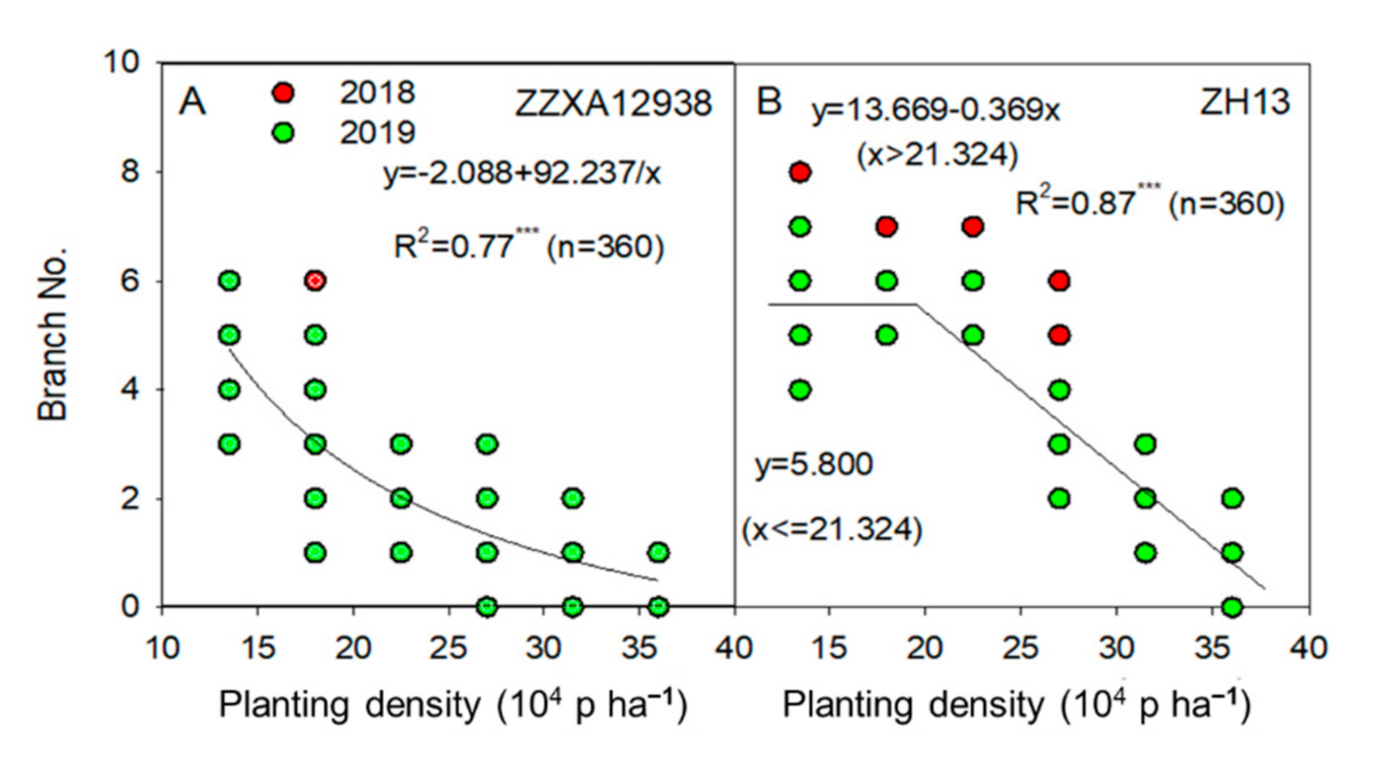
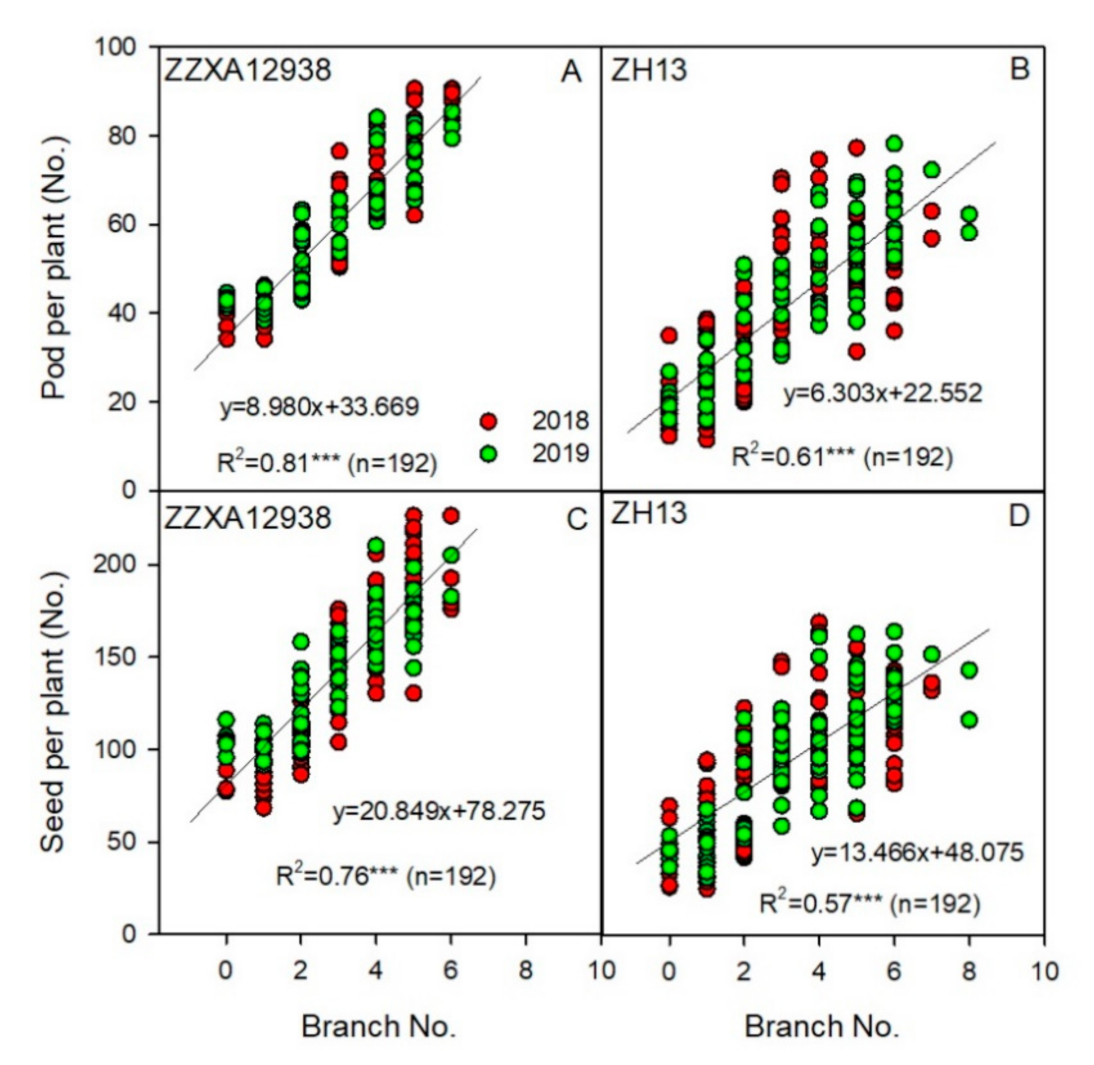
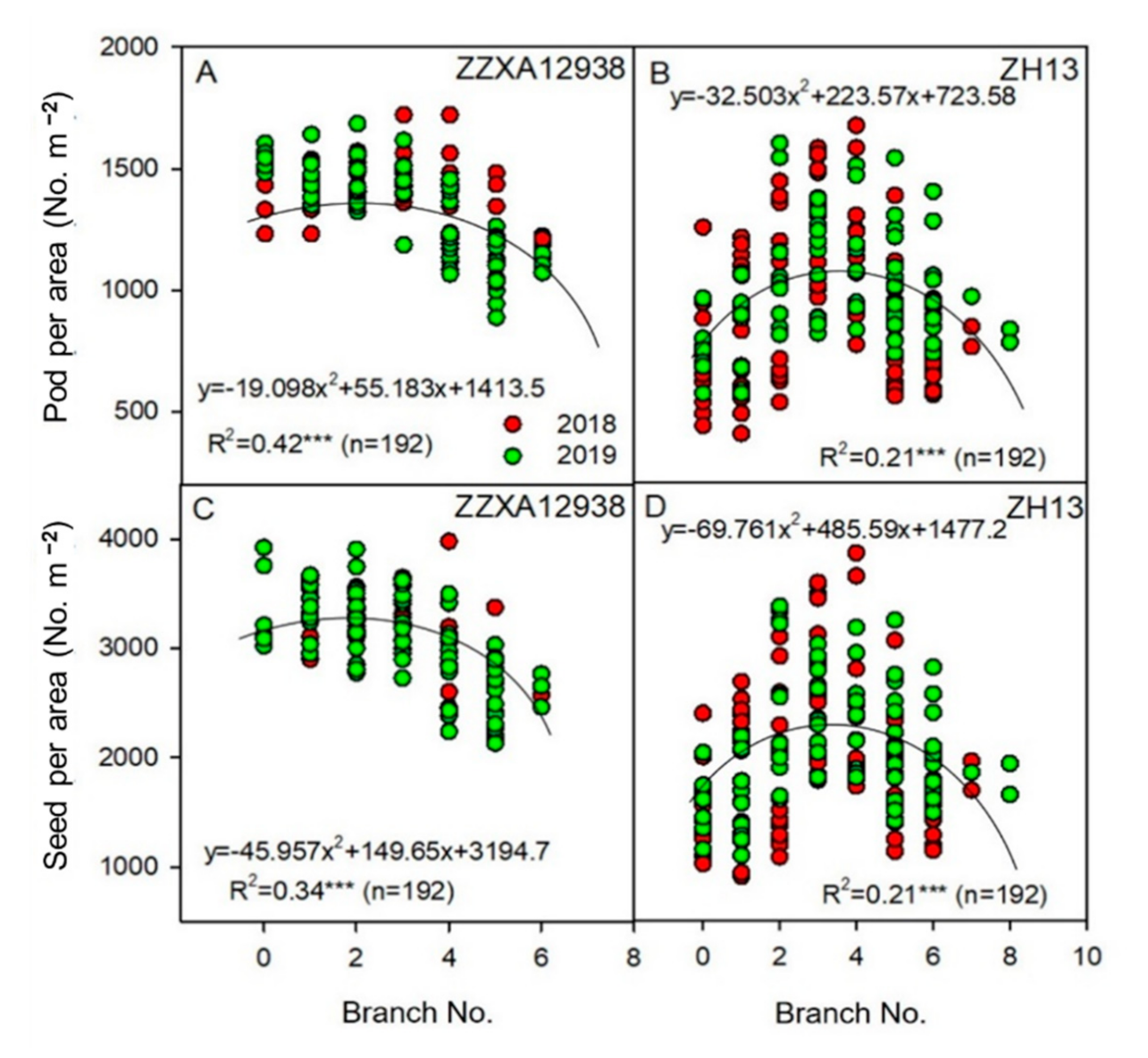
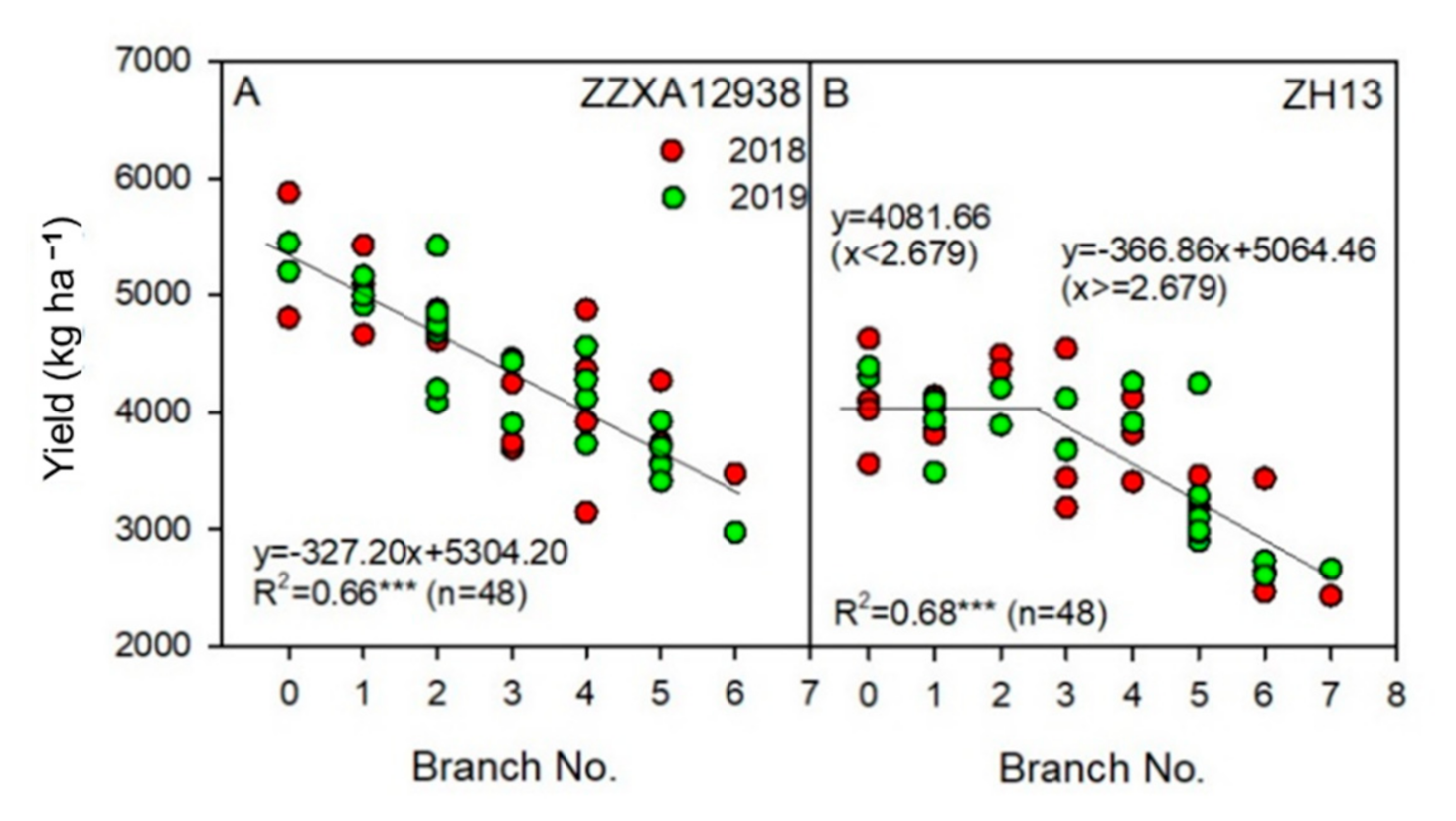
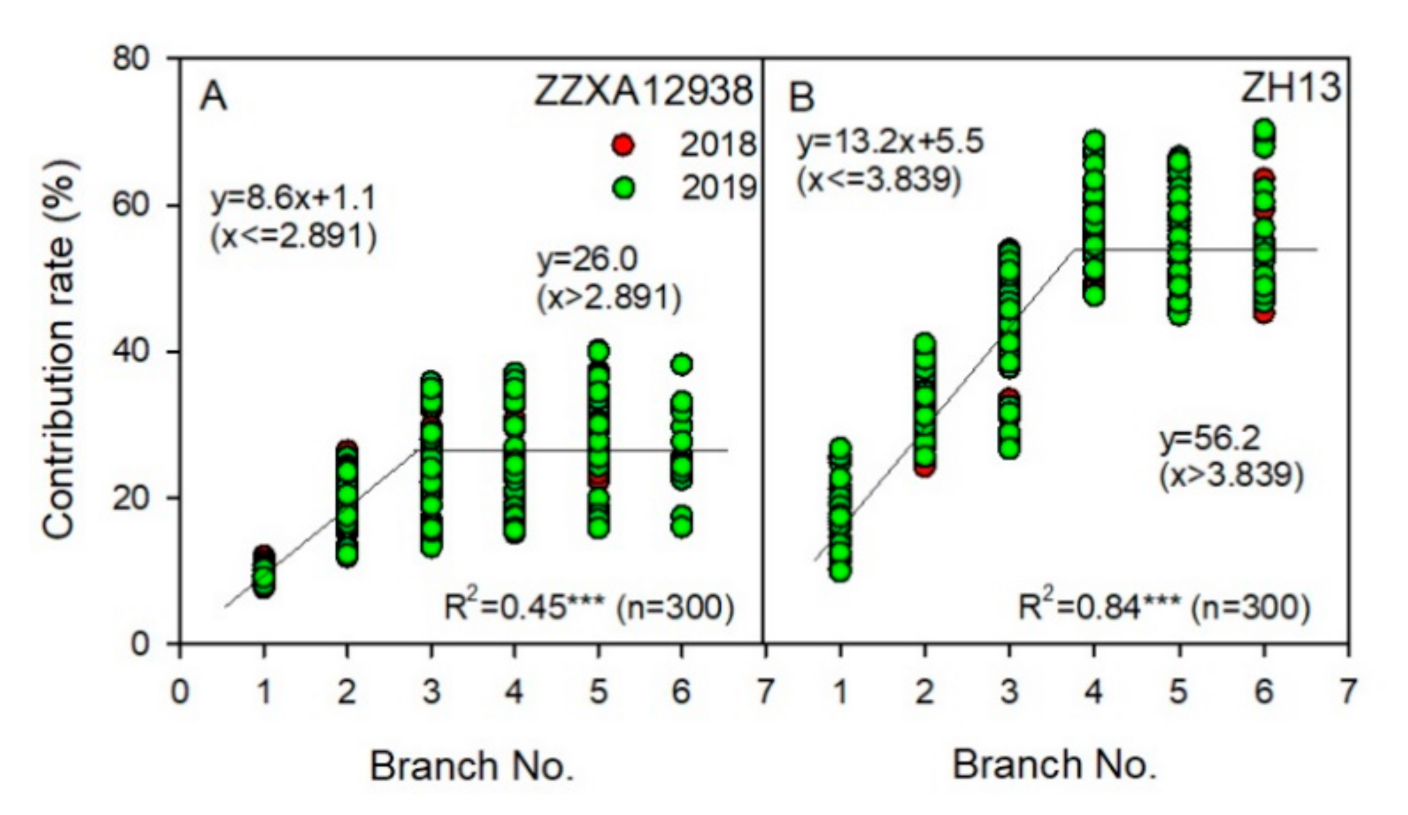
| Growing Month | Air Temperature (°C) | Rainfall (mm) | ||
|---|---|---|---|---|
| 2018 | 2019 | 2018 | 2019 | |
| June | 22.6 | 29.1 | 75.4 | 59.9 |
| July | 27.8 | 29.7 | 78.5 | 30.8 |
| August | 29.5 | 27.1 | 72.7 | 114.6 |
| September | 29.0 | 23.0 | 35.3 | 73.5 |
| October | 16.3 | 16.4 | 0.2 | 64.5 |
| Factor | Seed No. | Pod No. | Hundred-Seed | Yield | |||
|---|---|---|---|---|---|---|---|
| Plant−1 | Area (m−2) | Plant−1 | Area (m−2) | Weight (g) | (kg ha−1) | ||
| Year | 2018 | 120.4 b | 2759.2 b | 53.2 a | 1215.2 a | 19.6 b | 4052 a |
| 2019 | 123.6 a | 2912.3 a | 51.6 b | 1190.8 b | 21.6 a | 3924 a | |
| Cultivar | ZZXA12938 | 146.7 a | 3397.2 a | 60.4 a | 1364.8 a | 16.8 b | 4389 a |
| ZH13 | 97.3 b | 2274.2 b | 44.4 b | 1041.2 b | 24.5 a | 3587 b | |
| Density | 13.5 | 164.0 a | 2214.3 e | 67.6 a | 902.5 d | 19.8 d | 3053 e |
| (104 × plant ha−1) | 18.0 | 144.6 b | 2602.1 d | 59.6 b | 1075.2 c | 20.2 c | 3546 d |
| 22.5 | 137.9 c | 3102.4 ab | 57.4 c | 1294.0 b | 20.4 c | 4012 c | |
| 27.0 | 111.8 d | 3135.0 a | 50.1 d | 1329.6 a | 20.9 b | 4315 b | |
| 31.5 | 95.2 e | 3036.2 b | 42.6 e | 1317.2 ab | 21.1 ab | 4477 a | |
| 36.0 | 78.7 f | 2924.4 c | 37.1 f | 1299.5 ab | 21.4 a | 4524 a | |
| Cultivar (C) | *** | *** | *** | *** | *** | *** | |
| Density (D) | *** | *** | *** | *** | *** | *** | |
| C × D | *** | *** | *** | *** | *** | *** | |
Publisher’s Note: MDPI stays neutral with regard to jurisdictional claims in published maps and institutional affiliations. |
© 2021 by the authors. Licensee MDPI, Basel, Switzerland. This article is an open access article distributed under the terms and conditions of the Creative Commons Attribution (CC BY) license (http://creativecommons.org/licenses/by/4.0/).
Share and Cite
Xu, C.; Li, R.; Song, W.; Wu, T.; Sun, S.; Hu, S.; Han, T.; Wu, C. Responses of Branch Number and Yield Component of Soybean Cultivars Tested in Different Planting Densities. Agriculture 2021, 11, 69. https://doi.org/10.3390/agriculture11010069
Xu C, Li R, Song W, Wu T, Sun S, Hu S, Han T, Wu C. Responses of Branch Number and Yield Component of Soybean Cultivars Tested in Different Planting Densities. Agriculture. 2021; 11(1):69. https://doi.org/10.3390/agriculture11010069
Chicago/Turabian StyleXu, Cailong, Ruidong Li, Wenwen Song, Tingting Wu, Shi Sun, Shuixiu Hu, Tianfu Han, and Cunxiang Wu. 2021. "Responses of Branch Number and Yield Component of Soybean Cultivars Tested in Different Planting Densities" Agriculture 11, no. 1: 69. https://doi.org/10.3390/agriculture11010069
APA StyleXu, C., Li, R., Song, W., Wu, T., Sun, S., Hu, S., Han, T., & Wu, C. (2021). Responses of Branch Number and Yield Component of Soybean Cultivars Tested in Different Planting Densities. Agriculture, 11(1), 69. https://doi.org/10.3390/agriculture11010069





